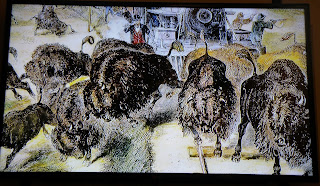A day of rest (and
cards, of course) and off again.
Women were not allowed in
the Beer Parlours without an escort,
and
Indians were not allowed
in the Beer Parlours at all.
I was raised in Southern Alberta and was oblivious to most of the Native
peoples around me. I knew there was a reserve around Pincher Creek and another
around Cardston but not much else. That was all before I started working with
First Nations People both here and in Cape Breton.
Gradually over the
years the Native Peoples have come into their own. The indigenous cultures have
become an important and integral part of the culture in Southern Alberta –
although there are still patches of non-acceptance on both sides.
The Blackfoot
Confederation is an interesting phenomenon. It is made up of three tribes — the
Blackfoot proper (Siksika), the Bloods (Kainai), and the Peigan (Pekuni). Each
tribe was independent, but they all spoke the same language and regarded
themselves as allies.
They were a
nomadic people and their movements were governed by the location of the
buffalo, along with the weather and the season.
Head Smashed in
Buffalo Jump has been
constructed to remember and celebrate the history and traditions of the Prairie
People. It was designated a National Historic Site in 1968, a Provincial
Historic Site in 1979, and a finally a World Heritage Site in 1981 for its
testimony of prehistoric life and the customs of aboriginal people.
The Head
Smashed in Buffalo Jump has long been a sacred place for the Blackfoot
tribes of Southern
Alberta as has Writing-on-Stone. More than sacred places, Buffalo Jumps were critical to
the survival of their people.
The
ever-present winds creates waves through the prairie grass that lead to the
imposing Rocky Mountains to the South
and the sacred Vision Quest Hill to the North.
The
winds and dark, cool weather soon drove us inside the building. The passageway
through the Centre unveils the environmental condition that enveloped the era
of the buffalo hunt; the life-style of the indigenous peoples; the buffalo hunt
itself and the consequence of Europeans migration.
Inside,
you will discover five levels of exhibits that explore: buffalo hunting
culture, the art of driving the great herds from the cliff, the eventual demise
of the buffalo hunting culture, and the work of archaeologists at
Head-Smashed-In.
I
was most taken with the depictions of the Buffalo Hunt – the most vital
aspect of their lives.
I
felt like we just scratched the surface of all there was to see and do. We’ll
need to go back again.





2 comments:
Did it explain how it got it's name?
Jaimie - that's an interesting question. Like most of the First Nation names, they tend to be very simple once you hear them. The cliff is so tall that the buffalo's heads got smashed in when they land at the bottom, hence the name. (answers.com)
Post a Comment